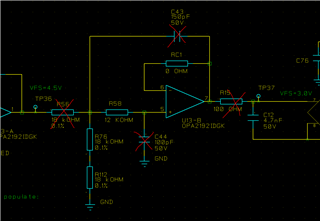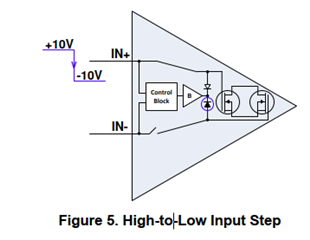Tool/software:
Hi,
this is a direct follow-up to my thread: "OPA2192: How does input bias current change close to supply rails?" I have found the root cause of my issues and wanted to share my findings. The original thread is locked. Therefore I have made this "related question".
First I reduced my circuit to this:

1. With no filter capacitors, passive pull-down at the input and no load at the output I measured 2.6mV at U13.7 and 3.3mV at U13.5. Good!
2. I then added C44 and measured 49.9mV at U13.7 and 50.4mV at U13.5. There is a DC current flowing out of the positive input terminal of the opamp at (50.4mV/(12k+36k))=1.05uA
3. I then implemented the same changes on a different board and the strange offset current was not present on that board!
4. I then started to add all the other changes to different functions on board nr 2 and the offset problem eventually also was visible on that board.
Long story short:
The root cause was found to be a decoupling cap that was removed to cost-optimize a different function on the board. When I added that capacitor back on the problematic board, the complete circuit including both amplifiers and filter caps is able to drive the ADC down to 6.2mV with all components mounted. Please note that we always had a 220nF capacitor close to the package for decoupling. The missing capacitor causing the issue was a 4.7uF capacitor placed somewhere along the track to the opamp.
My understanding of the problem (Speculation):
This opamp has a "mux-friendly" input protection that is described in SBOT040C Application Brief MUX-Friendly, Precision Operational Amplifiers:

I think the increased ripple voltage caused by my missing decoupling capacitor is misinterpreted by the control block as "input steps". This is (maybe?) causing the analog switches to toggle rapidly and you get some sort of "switched capacitor" behavior with a net DC current through the positive terminal. I do feel that the problem is under control now but it would be nice to have a comment from you to improve my understanding.
BR,
Øyvin Eikeland


